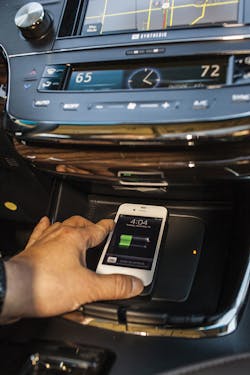Worldwide car production reached approximately 80 million units in 2012. Because of the relentless escalation of the vehicle population, it is important for in-car induction systems to be able to charge a broad range of devices—regardless of brand, manufacturer, or type of device. This is a key design consideration for vehicular infrastructures, where the diversity of user devices is high. To allow drivers charge their smartphones while driving, an in-vehicle wireless charging system using Qi and RF-identification (RFID) technology has been designed into the Toyota Avalon.
In this use case, all the driver does is place a Qi-protocol-enabled phone onto a charging mat, which forms part of the vehicle’s dash panel. This capability will be available in Avalon models released later this year. Qi wireless charging is currently available in 34 mobile-phone models. Here, the backwards compatibility of the Qi standard is critical, as it will ensure that the seamless charging experience is maintained as Qi technology evolves.
Toyota’s Avalon will feature a wireless charging system. Using Qi and RFID technology, it lets drivers charge their smartphones while driving. All the driver does is place his or her Qi-protocol-enabled phone onto a charging mat built into the dash panel.
In 2008, the Wireless Power Consortium signed an agreement for an open standard for wireless power. Called Qi, it is based on induction charging technology that involves transmitting energy via a magnetic field. Specifically, devices that operate with the Qi standard rely on magnetic induction between planar coils.
Two kinds of devices are involved: base stations, which provide inductive power, and mobile devices that consume inductive power. The base station has a power transmitter comprising a transmitting coil. In contrast, the mobile device has a power receiver that contains a receiving coil. Close spacing of the two coils—as well as shielding on their surfaces—ensures efficient inductive power transfer. The use of appropriate shielding is important because it reduces the driver’s long-term exposure to the electromagnetic field.
Qi power efficiency is typically claimed to be 70%. However, efficiency can drop to 40%, depending on the distances involved in the power transfer. In general, inductive charging has faced challenges due to lack of efficiency and increased resistive heating. In comparison to direct-contact charging methods, it also is more expensive in equipment terms. After all, it requires additional electronics and coils both in the device and charger.
Typically, these systems also are criticized because the device being charged has to stay positioned on the charging mat. When it comes to the in-vehicle use of wireless charging, however, this limitation actually offers a benefit: Unlike cable-connected recharging methods, it prevents drivers from using the phone while driving.
Unlocking Avalon’s Charging System
The Avalon’s wireless-charging system relies on technology developed by Hong Kong-based ConvenientPower and Philips & Lite-On Digital Solutions (PLDS). ConvenientPower is a specialist in wireless power charging and related intellectual property (IP). It co-designed Qi and co-founded the Wireless Power Consortium, which now has about 100 members including Samsung, Nokia, HTC, Motorola Mobility, and Sony. For its part, Philips & Lite-On Digital Solutions designs and develops optical-disc-drive products for automotive applications. Its major research center is based in Germany.
An important element in the continuing implementation of induction charging is ensuring that systems can recognize different products and how much charge they need. Israeli company Powermat uses RFID tags to identify what is being placed in the charging position. The RFID tags are held in a case made to fit around popular gadgets like iPods, laptops, and mobile phones. When a gadget is positioned on a Powermat, it reads the RFID tag to identify the device and ensure that it receives only the charge it requires.
Toyota is predicting sales of 70,000 for its Avalon vehicles in 2013. If that estimate is reached, the car will probably be a bigger hit than the music single “Avalon,” by Bryan Ferry and Roxy Music—and maybe those other few songs with “Avalon” in their title as well.


